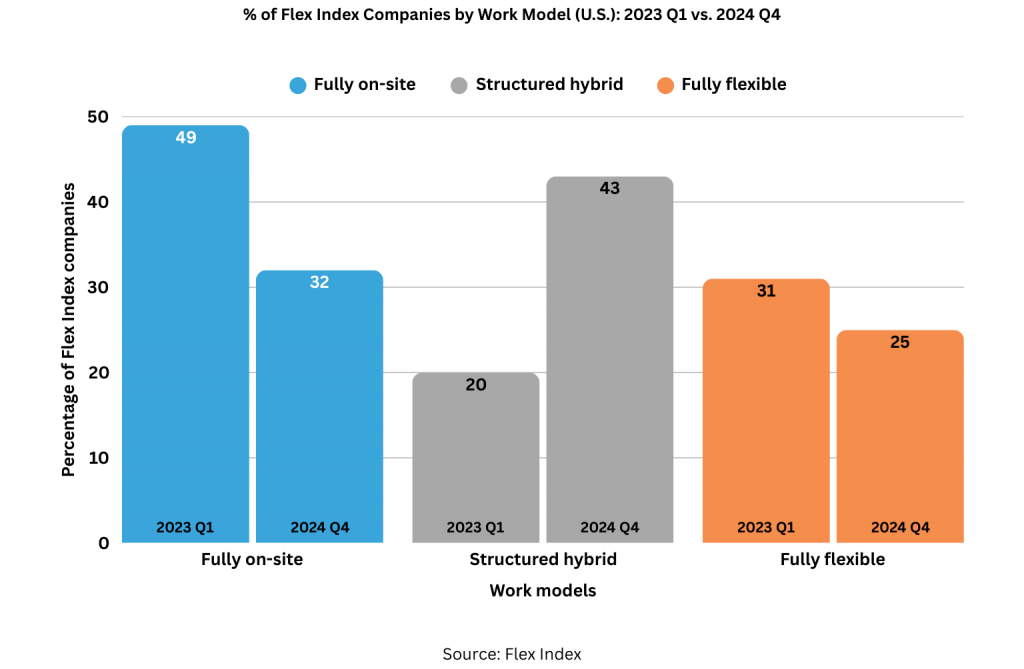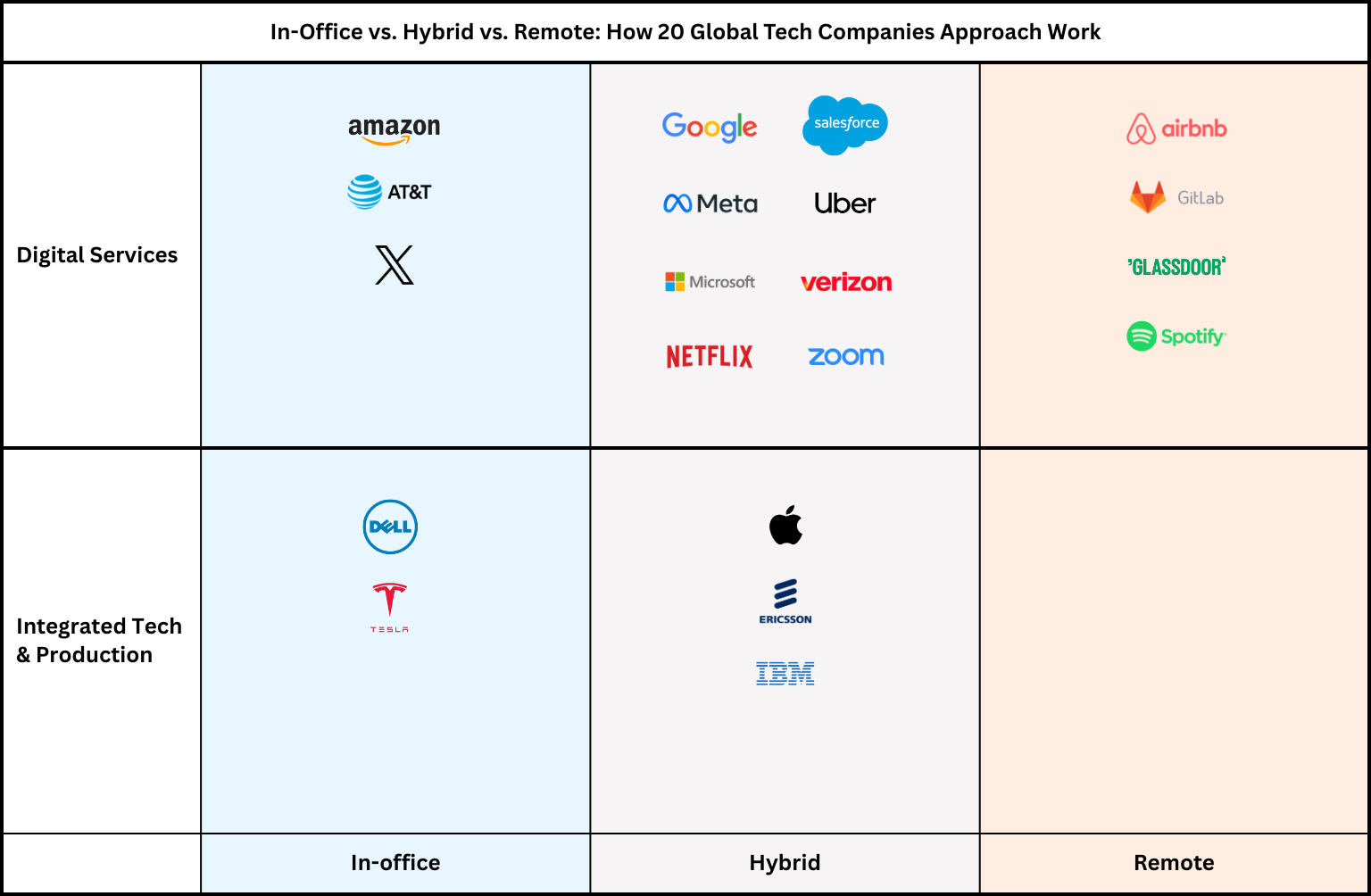Before the COVID-19 pandemic, the potential and tools for flexible work were already there for many roles, but it took a global health emergency for us to put theory into practice. When it happened, we all unexpectedly found ourselves as part of an unintended global experiment that demonstrated that remote work was viable.
It seemed like we were beginning to experience the future of work. Employers gained the possibility to hire from anywhere in the world, broadening their talent pools. Employees began to spend less on food, transportation, and clothing, and were given their commuting time back as free time. Inclusivity was also among the many benefits, not only for neurodivergent people and caregivers but also for people of color and LGBTQ people who could avoid microaggressions at the office or simply choose to live in more diverse communities.
However, five years after the onset of COVID-19 and the surge in remote work, return-to-office (RTO) policies seem to be taking over. But is this really the case? Or is it simply a tendency for us to discuss these mandates, making a trend seem bigger than it actually is?
According to Flex Index, which gathers data on workplace arrangements in U.S. companies, fully in-office work has been declining: in the first quarter of 2023, 49% of employers required full-time in-office work; in the final quarter of the following year, 2024, that percentage had decreased to 32%.
Conversely, companies are also distancing from a fully remote work model: in the first quarter of 2023, 31% of employers operated fully remote, but by the final quarter of 2024, only 25% remained that way.
Instead, businesses are increasingly adopting structured hybrid arrangements. In the first quarter of 2023, about 20% of employers had hybrid work models. By the final quarter of 2024, this share had risen to 43%.

It’s important to note that the choice between in-office, remote, or hybrid work arrangements varies significantly depending on the industry and the company size. The Flex Index Report for 2024 Q4 indicates that in the U.S., 70% of companies with fewer than 500 employees are fully flexible, while just 14% of enterprises with 25,000 or more employees are fully flexible. Big companies may mandate RTO for various reasons, from the intrinsic difficulty of coordinating huge teams remotely to making use of expensive real estate.
Let’s look at the various approaches by major tech companies regarding the adoption of in-office, remote, or hybrid work models.

Alphabet (Google)
In 2023, Google requested employees to work in the office three days a week. When the request went ignored by many Googlers, the company told them that non-compliance could show up in performance reviews, according to the Washington Post.
In February this year, co-founder Sergey Brin wrote in an internal memo viewed by The New York Times: “I recommend being in the office at least every weekday.” Brin views RTO as key to winning the AI race. In the message, directed to employees who work on Gemini, Google’s AI model, he added that working “60 hours a week is the sweet spot of productivity.” The outlet clarifies that Brin’s memo does not alter Google’s official hybrid policy.

Airbnb
Airbnb announced their “live and work anywhere” remote work policy in April 2022, allowing the company’s employees to “live and work in over 170 countries for up to 90 days a year in each location.” The only condition is that they meet up regularly for in-person team gatherings.
“I think there’s a huge value to people being in the office sometimes. I have not found a huge value in people being in the office all the time,” CEO Brian Chesky said in a podcast in January this year, adding, “So, let’s say you’re a global company. I want everyone to be together, but everyone lives in different cities, right? So unless all of your employees live within a 30-minute commuting radius, you either have to limit your hiring to a very narrow talent pool, or you’re hiring all over the world, and you have all these offices, and you’re telling people to go into an office. But they’re going into an office. Who cares? What I want is, for the most part, people coming to the San Francisco office, but I can’t get everyone to move here to San Francisco, and I can’t get them to fly here every week. So I have a simple rule: we basically ask people to come to San Francisco one week a month.”
Chesky explained the gathering weeks: “It’s typically one week a month where we coordinate everyone being together, and that’s for collaboration.” He summarizes: “We have a flexible policy where you come in one week a month, and otherwise, we’re flexible. This allows us to not make a trade-off regarding where employees are, and I think the one week we’re in the office is superior to other companies where people are in different offices, right? All of our leaders are in the same office. They’re not in different offices.”
When asked whether the costs of flying employees to San Francisco were worth it, Chesky emphasized the real estate savings and highlighted, “If this new model was more expensive than the old model, it still might be superior because I think the output for us is superior. But my understanding is that this is still, on balance, more affordable.”
In a 2023 interview with NPR, Airbnb’s Dave Stephenson (then Chief Financial Officer, now Chief Business Officer) declared, “We are just being intentional about how we gather. It’s not a random three days a week where you hope to run into people at a water cooler.”
It should be noted that employees who can work anywhere in the world just by carrying their laptops are potential guests and hosts for Airbnb. And if more companies adopted this flexible work model, Airbnb would benefit even further. As a homestay marketplace, Airbnb stands to benefit from fully remote work, and its work model is, therefore, a logical choice.
Amazon
Amazon had the most talked-about RTO mandate, affecting 350,000 workers and inspiring many other techs to do the same. On September 16 last year, CEO Andy Jassy mandated corporate employees return to the office five days per week, sparking outrage on social media and a surge of “rage apply.”
In Jassy’s words: “we’ve decided that we’re going to return to being in the office the way we were before the onset of COVID.” Among his reasons, he listed: “we’ve observed that it’s easier for our teammates to learn, model, practice, and strengthen our culture; collaborating, brainstorming, and inventing are simpler and more effective; teaching and learning from one another are more seamless; and, teams tend to be better connected to one another.”
He emphasized, “our expectation is that people will be in the office outside of extenuating circumstances.” He also stressed that the mandate would only take effect on January 2 of this year to ensure a smooth transition, allowing workers time to make any necessary adjustments to their personal lives.
While Jassy’s original announcement stressed that Amazon’s Global Real Estate and Facilities (GREF) would be “working on a plan to accommodate desk arrangements,” reality set it with its challenges, and media has reported issues such as insufficient desks and parking spaces. In February, The Wall Street Journal reported that, due to a lack of space, the company had postponed RTO for staff assigned to “dozens” of U.S. offices. One month after the mandate took effect, Amazon employees assigned to some locations were still working remotely while awaiting further instructions. Meanwhile, those returning to the office reported that their teammates were not in the same location and, therefore, were still having virtual meetings — which poses challenges to the very objectives of in-person work outlined by Jassy.
An Amazon spokesperson told the WSJ that “the overwhelming majority of our employees have dedicated workspaces” and that “of the hundreds of offices we have all around the world, there are only a relatively small number that are not quite ready to welcome everyone back a full five days a week.”
Apple
Unlike other tech giants such as Google or Meta, Apple is, in part, a hardware company, meaning that it has an intrinsic need for some on-site work. So, while it had to adapt to remote work during the coronavirus pandemic, the company started to try to implement the hybrid work model as early as June 2021, amid employee backlash and the delta variant of the coronavirus. In August 2022, CEO Tim Cook ordered employees to start returning to the office three days a week starting September that year.
The decision was met with protest, and a petition by a group of workers stated, “Those asking for more flexible arrangements have many compelling reasons and circumstances: from disabilities (visible or not); family care; safety, health, and environmental concerns; financial considerations; to just plain being happier and more productive.”
Apple suffered some losses due to the policy, including the director of machine learning, Ian Goodfellow, who chose to rejoin his previous employer, Google, in May 2022, explicitly citing the lack of flexibility as the reason for his departure.
However, as Vox summarized, Apple has the upper hand: “The company offers workers hard-to-beat pay, benefits, and prestige, so it’s capable of retaining most of its workforce and continuing to attract top talent, regardless of its stance on flexible work. Other companies will either copy Apple’s remote work policies and risk losing more workers than Apple would — or they’ll try to compete with the tech giant by offering something it won’t.”
AT&T
In December last year, U.S. telecom giant AT&T mandated five-day office attendance starting January this year.
Implementation has been challenging, though, with employees reporting issues like insufficient desk space and parking spaces. Meanwhile, competitor Verizon is capitalizing on AT&T’s RTO policy and wooing disgruntled staff, as we will see later on. Stay tuned.
Dell
In February, Dell put an end to its hybrid work model and mandated that all employees within an hour of a company office should report to their desks five days a week. CEO Michael Dell stated in a memo, “Starting March 3, all hybrid and remote team members who live near a Dell office will work in the office five days a week. We are retiring the hybrid policy effective that day.”

Ericsson
Corporate employees are expected to go into an office 50% of the time, according to Flex Index. However, the media reported in October last year that the requirement had increased to 60% and caused trouble (e.g., staff taking meetings in the toilets due to a lack of meeting rooms).
Ericsson’s PR department stated about the percentage issue: “The policy should be seen as a recommendation rather than a strict requirement where we want our employees to understand the importance of meetings between people. Ericsson trusts its employees.”
GitLab
GitLab is a company that cannot mandate its workers to return to the office, at least not literally, because it has never had an office. An all-remote company since its inception in 2011, it has over 2,300 team members distributed in 60 countries. Harvard Business School and INSEAD have studied the work model of the DevSecOps (Development, Security, and Operations) platform.
GitLab’s career page highlights flexibility as its employer value proposition: “GitLab’s unique approach offers flexibility that allows team members to experience truly meaningful moments.” The company also shares comprehensive resources about remote work with the public.
Glassdoor
Glassdoor, the dreaded platform where workers go to anonymously review their current or former employers (and complain about RTO mandates, of course), is fully remote. In February last year, the company announced that it was closing its last remaining offices in Chicago and San Francisco.
In November, CEO Christian Sutherland-Wong told Fortune, “I think the biggest benefit we’ve seen, being a fully remote workplace, is being able to tap into talent all around the U.S. and all around the globe that we didn’t have access to when we were an office-based company. And that’s been a powerful change to the talent we’ve been able to bring on.”
He also reflected on how different models work for different-sized companies: “At the beginning of the pandemic, it felt like the large tech companies would embrace a remote-work future, but now the pendulum has swung back and you see a lot of them mandating a return to office, at least a few days a week. I think that’s a reflection of: While you can do many things remotely, you lose some connection and brainstorming opportunities. That’s why larger tech companies have swung back a bit.” Conversely, for a company like Glassdoor, which is global and renowned but far from being a big tech, and that is not manufacturing anything, remote work may be the most suitable model. “Glassdoor has chosen to really embrace remote because it feels like the right decision for us,” said Sutherland-Wong.
IBM
IBM requires corporate employees to go into an office at least three days a week. In January last year, a note sent by then Senior Vice President John Granger, viewed by Bloomberg, informed those still working remotely to either live close to an IBM office or resign. Some saw the RTO mandate as a back-channel layoff.
The company has consistently viewed remote work as having certain limitations. In May 2023, CEO Arvind Krishna declared to Bloomberg that career advancement would be tougher for those working remotely: “In the short term you probably can be equally productive, but your career does suffer. Moving from there to another role is probably less likely because nobody’s observing them in another context. It will be tougher. Not impossible, but probably a lot tougher.”
Meta
The Facebook and Instagram parent company operates a hybrid work model, with most employees expected to work in an office at least three days a week since 2023.
In January this year, Mark Zuckerberg stated that he had no plans to change the hybrid work policy.
Microsoft
Microsoft operates a hybrid model. According to Flex Index, corporate employees are expected to go into an office 50% of the time.
“If you make the time to do it right, your employees will be more engaged, more productive, and more connected, even when they’re miles away. And they’ll be far less likely to leave for a competitor who has a more sophisticated and flexible model than you do”, wrote Keith Boyd, Senior Director at Microsoft Digital, in a company blog post.
Netflix
Corporate employees are expected to go into an office on Tuesdays and Thursdays, according to Flex Index. On social media, employees often report that the office attendance rules vary a lot depending on the team.
Salesforce
In July last year, Salesforce mandated that certain employees return to the office “four to five days a week,” according to an internal memo viewed by The San Francisco Standard. The directive extended beyond just the San Francisco headquarters, according to the media.
The news surprised some as, in 2022, Salesforce CEO Marc Benioff had spoken out against RTO mandates, saying they were “never going to work.” In 2023, he also declared, “I’ve always been a remote worker my whole life. I don’t work well in an office. It just doesn’t work with my personality.”
Spotify
The Swedish company launched its “work from anywhere policy” in 2021, communicating its belief that “Work isn’t something you come to the office for, it’s something you do.” and its intention to tap into new talent pools.
“You can’t spend a lot of time hiring grown-ups and then treat them like children,” said Katarina Berg, then Spotify’s CHRO, to Raconteur. “We are a business that’s been digital from birth, so why shouldn’t we give our people flexibility and freedom?”
While Berg conceded that remote collaboration poses its challenges, she emphasized the company’s commitment to flexible work: “But does that mean that we will start forcing people to come into the office as soon as there is a trend for it? No.”

Tesla
In 2022, CEO Elon Musk said that employees must work from the office at least 40 hours per week. According to the media, in a memo headlined “Remote work is no longer acceptble” [sic], Musk wrote: “Anyone who wishes to do remote work must be in the office for a minimum (and I mean *minimum*) of 40 hours per week or depart Tesla. This is less than we ask of factory workers.”
Like Apple, Tesla is a manufacturing company, so it has an intrinsic demand for some on-site work, at least for some of its corporate workers. In his emails to Tesla staff, Musk has communicated his belief in the advantages of having white-collar employees work close to the factory.

Uber
Uber operates a hybrid work model, requiring most corporate employees to spend at least half of their work time in the office. According to the company’s blog, Tuesdays and Thursdays are designated as ‘anchor days,’ that is, days when “all non-remote employees are expected to be in the office.” The wording indicates that the company has remote employees, as the post explains later on: “We also have flexibility for some employees to be fully remote, depending on their role and location. This enables us to hire and retain employees outside of our hub office locations.”
In addition, Uber employees can work from anywhere for up to four weeks per year.
Verizon
In a strategic move, Verizon has targeted competitor AT&T employees who are unhappy with their employer’s five-day in-office mandate. In a direct recruiting email viewed by Business Insider, the telecom giant positioned itself as the flexible alternative in the industry: “Following the news of changing RTO policies across the industry, we’re reaching out to share helpful resources and potential hybrid/remote job opportunities across Verizon. If you have been personally affected by organizational policy changes or know anyone who has, we’re looking to add top talent to the V team.”
Verizon’s approach demonstrates how workplace flexibility has become a competitive advantage in talent acquisition.
X (formerly Twitter)
In May 2020, Twitter’s CEO and co-founder Jack Dorsey implemented the “work from home forever” policy.
In March 2022, the new CEO Parag Agrawal reinforced the company’s commitment to offering fully remote work forever for those who preferred this model: “Wherever you feel most productive and creative is where you will work and that includes working from home full-time forever.” Meanwhile, Elon Musk tweeted about converting Twitter’s San Francisco headquarters into a “homeless shelter since no one shows up anyway,” along with a poll allowing users to agree or disagree.
Agrawal was fired as CEO once Musk completed his acquisition of Twitter in October of that year. One of Musk’s first moves was to reverse the company’s “work from home forever” policy. X mandates full-time office attendance; that is, employees are required to work five days in the office.
Unlike Tesla, X is not a manufacturing business, meaning it doesn’t have an inherent necessity for on-site work. However, as a globally recognized brand that originated in the early days of social media as Twitter, X offers its employees a certain level of prestige in exchange for reduced flexibility.
Zoom
One of the most emblematic cases of the RTO trend is Zoom, a company that greatly benefited from the shift to remote work. The videoconferencing platform experienced a dramatic increase in daily meeting participants during the first months of the pandemic, rising from 10 million in December 2019 to over 300 million by April 2020 — an astounding growth of 30 times within just a few months.
In August 2023, however, the company shifted from a remote model to a hybrid one, telling workers who live a “commutable distance” of a company office (defined as within 50 miles, or 80 kilometers) to report to their desks at least twice a week, effective immediately.
Key takeaways
First, when analyzing macro data on work models, we see that hybrid is gaining more adepts among employers, while fully remote and strictly in-office models are on the decrease. So, regardless of all the noise and seismic activity generated by each new RTO policy issued by some big tech, the overall trend does not indicate a massive return to the office.
When analyzing the choices made by some global tech companies regarding their work models — whether in-office, fully remote, or hybrid — three key factors emerge: whether the company is a manufacturing business, the company size, and the prestige it holds for its employees.
Manufacturing companies like Apple or Tesla will always require some level of on-site work due to the nature of their operations. While this doesn’t mean there’s a need for every and single one of its corporate employees to work in-office five days a week, the requirements and context are inherently different from pure software companies. Moreover, in production companies, having drastically different rules for blue-collar and white-collar workers could lead to tension.
Companies producing tools that enable remote collaboration, like GitLab, are more likely to be fully remote, as they have a point to prove — Atlassian and GitHub are also remote-first. However, this is not a rule, as Zoom, an icon of the rise of remote work, operates hybrid.
Then there’s the case of Airbnb, a business that would thrive even more in a world where employees work remotely from anywhere — a world where work doesn’t limit mobility and tourism isn’t restricted to vacation time. Their profits would skyrocket. Therefore, it’s only logical for Airbnb to implement a work-from-anywhere policy. Inspiring other companies to do the same is good for business.
The company size also influences its choice of work model, with “smaller” companies like GitLab and Glassdoor opting for a fully remote work model. Asynchronous communication is a lot easier in smaller teams than in huge ones.
Another factor is the career impact of working for prestigious companies like Amazon or Tesla. Even a short tenure at such companies can significantly enhance a person’s career prospects, impressing recruiters for years to come. This may make talent more willing to forgo flexibility and comply with RTO mandates. However, not all Amazon or Tesla employees will make this choice, or at least not for good. Many will prefer to give up prestige in the name of flexibility, which opens opportunities for other companies to attract talent by offering flexible work arrangements.
As Daan van Rossum of FlexOS noted in an article, the decision ultimately comes down to a question that must be answered with sheer honesty: “Are people lucky to work for me, or am I lucky to have these people?”
You’re clearly someone who likes to stay informed and updated
Continue the journey by joining the TechTalents Insights community and getting every-other-week trends and expert insights — completely free, straight to your inbox. Click here to subscribe.




